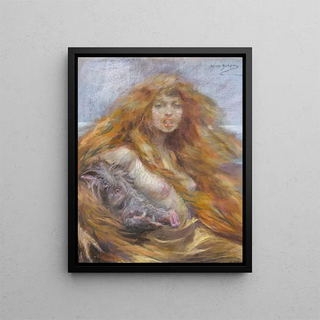Art print | Circe - Alice Pike Barney Source: Reproduction | Circé - Alice Pike Barney


View from behind

Frame (optional)
In the fascinating world of art, some works transcend their era to become timeless witnesses of human creativity. "Circé" by Alice Pike Barney is undoubtedly one of these iconic pieces. This canvas, evoking mythology and feminine beauty, transports the viewer into a universe where reality and the fantastical intertwine. The artist, through her depiction of the famous sorceress from the Odyssey, manages to capture the very essence of femininity while exploring universal themes such as power, seduction, and transformation. Every brushstroke seems to whisper forgotten stories, inviting deep and enriching contemplation.
Style and uniqueness of the work
Alice Pike Barney's style is both bold and delicate, blending Impressionist and Symbolist influences. In "Circé," vibrant colors and flowing lines create a dreamlike atmosphere, where every detail is carefully considered. The representation of Circé, surrounded by animals and symbols, evokes a nature that is both wild and controlled. The play of light and shadow, along with rich textures, adds an almost tactile dimension to the piece. What truly sets this work apart is how it humanizes a mythological character, giving her an emotional depth that resonates with the contemporary audience. The artist succeeds in establishing a dialogue between the past and the present, making "Circé" a work of striking modernity.
The artist and her influence
Alice Pike Barney, though less known than some of her contemporaries, left an indelible mark on the art world. Born at the end of the 19th century, she managed to establish herself in an artistic environment dominated by men, challenging the conventions of her time. Her innovative approach and unique sensitivity allowed her to explore diverse themes, often related to the female condition and mythology. Barney was also a pioneer in the use of color and light, influencing many artists who followed her. Her work "Circé" is emblematic of her talent, illustrating how

Matte finish

View from behind

Frame (optional)
In the fascinating world of art, some works transcend their era to become timeless witnesses of human creativity. "Circé" by Alice Pike Barney is undoubtedly one of these iconic pieces. This canvas, evoking mythology and feminine beauty, transports the viewer into a universe where reality and the fantastical intertwine. The artist, through her depiction of the famous sorceress from the Odyssey, manages to capture the very essence of femininity while exploring universal themes such as power, seduction, and transformation. Every brushstroke seems to whisper forgotten stories, inviting deep and enriching contemplation.
Style and uniqueness of the work
Alice Pike Barney's style is both bold and delicate, blending Impressionist and Symbolist influences. In "Circé," vibrant colors and flowing lines create a dreamlike atmosphere, where every detail is carefully considered. The representation of Circé, surrounded by animals and symbols, evokes a nature that is both wild and controlled. The play of light and shadow, along with rich textures, adds an almost tactile dimension to the piece. What truly sets this work apart is how it humanizes a mythological character, giving her an emotional depth that resonates with the contemporary audience. The artist succeeds in establishing a dialogue between the past and the present, making "Circé" a work of striking modernity.
The artist and her influence
Alice Pike Barney, though less known than some of her contemporaries, left an indelible mark on the art world. Born at the end of the 19th century, she managed to establish herself in an artistic environment dominated by men, challenging the conventions of her time. Her innovative approach and unique sensitivity allowed her to explore diverse themes, often related to the female condition and mythology. Barney was also a pioneer in the use of color and light, influencing many artists who followed her. Her work "Circé" is emblematic of her talent, illustrating how






